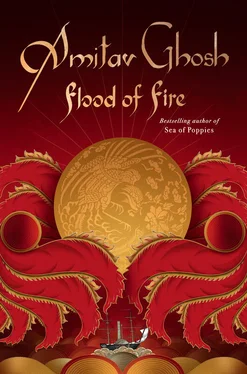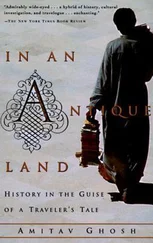The formation was like an arrowhead, pointed directly at the forts of North Wantung Island. The island was sphinx-like in shape, with its head facing the British fleet. Upon its crown sat a massive battery, the gun-ports of which were already open, with the muzzles pointing at the warships. The surrounding shores were ringed by an almost continuous circle of fortifications; battlements ran up and down the slopes, ranging over the promontories and peaks of the Tiger’s Mouth.
From the quarter-deck of the Ibis Zachary had a fine view of the preparations for the attack. Of the fleet’s complement of steamers, three were busy paddling around the anchored vessels. Only one steamer was stationary, the Nemesis — but that was only because she was to be the spearhead of the coming attack. Half a dozen longboats were clustered around her, discharging men and munitions; a string of cutters was attached to her stern, ready to be towed.
Just as the sun was going down a cloud of dense black smoke spurted from the tall funnel of the Nemesis . As steam built up in her boilers she seemed to quiver and shake, like a racehorse chomping at the bit. Then all of a sudden she darted forward, pulling three cutters behind her, heading towards the islet of South Wantung.
South and North Wantung were separated by a narrow strip of water. South Wantung was of negligible size: had it not been topped by a couple of small hillocks it could have been mistaken for a mudflat. Like a mouse beneath a cat, it seemed to cower in front of its lofty neighbour to the north.
As the Nemesis moved towards South Wantung two Chinese batteries opened up simultaneously, one from the heights of North Wantung, and the other from across the water, at Humen. The first few shots went astray and before the Chinese gunners could find their range the Nemesis had edged close to the shore of the islet. She pulled up to a beach that was protected by a hillock.
While the batteries of North Wantung continued to pound away, ineffectively, a landing party leapt ashore. All of a sudden the dun-coloured hillocks of the islet were aswarm with the blue uniforms of artillerymen.
Zachary’s spyglass was now riveted on the islet: having been trained as a shipwright he had a professional interest in the ways in which things were assembled and taken apart. He was captivated by the scene that now unfolded on South Wantung — two hundred men working together with the synchronized precision of wasps building a nest.
The gun-lascars of the Madras Artillery had brought a stack of gunny sacks with them; these they now proceeded to fill with sand from the shore. As the sacks accumulated they were passed from hand to hand, up to the saddle that separated the island’s two hillocks. Here, sheltered by the slope, stood an officer of the Royal Artillery; under his direction the sandbags were stacked to form a protective breastworks.
In the meantime squads of artillerymen were lowering an arsenal of dismantled weaponry from the Nemesis . A set of massive brass and iron barrels came first, each of them weighing half a ton or more; they were followed by the wheels and limbers of their carriages. The various parts were put together with astonishing speed and before the sun had gone down the makings of a small battery were already visible on the beach.
The fusillades from the Chinese batteries had been intensifying steadily all this while. The islet took many hits, but because of the intervening hillock none caused any harm to the artillerymen.
When night fell the Tiger’s Mouth became a vast panorama of light and fire. On the surrounding headlands the cooking-fires of the Chinese troops flickered dimly in the darkness. And all the while the guns on North Wantung continued to shoot so that the heights of the island looked like the mouth of a smouldering volcano, constantly ejecting tongues of flame.
On the protected side of the islet too, lights glimmered through the night as the British and Indian artillerymen went about the business of erecting the battery. When daylight broke it was seen that they had succeeded in finishing the job — a small artillery park, sheltered by a thick wall of sandbags, had arisen in the saddle between the island’s two hillocks. It consisted of three howitzers, two eight-inch field-pieces and a brass twenty-four-pounder. Behind the gun-carriages was a platform for the launching of Congreve rockets.
At about eight in the morning, with clear skies above and the whole estuary bathed in bright sunlight, the newly erected British battery opened up. The first rounds fell short, with the shells slamming into the cliff of North Wantung, gouging out clumps of rock and earth. But slowly the impacts crept up the rock-face until they began to crash into the walls of the battery, knocking out embrasures and castellations. Soon the field-pieces switched to canister and grapeshot, sending a hailstorm of musket-balls into the Chinese gun-emplacements. Then a flight of Congreve rockets, armed with explosives, took to the air. A series of blasts followed as they arced over the battlements. A powder magazine blew up and the explosion pushed a massive sixty-eight-pounder through its gun-port: it teetered on the edge for a moment and then toppled over and went spinning down the cliffs, with a great clanging of metal on rock. A plume of water shot up as it bounced off a boulder and plunged into the channel.
By this time the British fleet had separated into three squadrons in preparation for the coming attack. For a while the ships were held back by the retreating tide; nor was there a breath of wind to fill their sails. The pounding of North Wantung continued while they waited for a breeze; in the windless air smoke and debris rose from the island’s heights in roiling clouds, as if from a belching volcano.
It was past ten when a breeze stirred the air. Hoisting sail, the largest of the three squadrons set off for Humen, to the east; it was led by two seventy-four-gun line-of-battle frigates, Melville and Blenheim . The second squadron headed westwards, towards the restored fort of Tytock on the other shore: it consisted of only two vessels, the Wellesley and the twenty-four-gun Modeste . The third squadron converged on the battered and smoking island of North Wantung. Accompanying each group of attack vessels was a complement of rocket-boats.
Till this time no British warship had fired a single shot. Now, as the squadrons drew abreast of the gun-emplacements, they dropped anchor with springs on their cables, so that they could stay beam-on to their respective targets. Then, almost simultaneously they unloosed their broadsides at all three sets of defences — Humen, Tytock and North Wantung. The thunder of their cannon was accompanied by the shriek of Congreve rockets.
The firing was of such concentrated ferocity that it was as if a deluge of metal and flame had swept around the channel, setting fire to the water itself. As broadside followed upon broadside a dark thundercloud blossomed around the Tiger’s Mouth: the fumes were so dense that the warships had to stop firing to let the air clear.
When the smoke lifted it was seen that much of the Chinese artillery had been knocked out. The fort of Tytock had fallen silent while the guns at Humen and North Wantung were firing only sporadically. At all three points the battlements and defences had been badly battered and breached.
Now, as preparations for the ground assault got under way, the warships redeployed: the Wellesley and Modeste had already succeeded in reducing the fort of Tytock to a smoking ruin. Turning away, they crossed over to join in the attack on North Wantung.
It was only now that Zachary could bring himself to lower his telescope: he had watched the entire operation with breathless excitement, focusing now on the channel’s right bank, now on the left, and sometimes on the island in the middle.
Читать дальше












